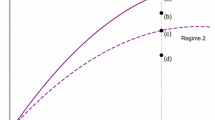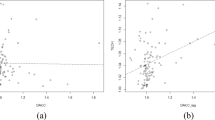Abstract
In March 2000, all the heads of government and of states of the European Union (EU) gathered in Lisbon (Portugal) to develop a strategic plan for Europe for the next ten years. This plan was known as the Lisbon Agenda, and it sought to make the EU the world’s most competitive economy within a decade. That decade has now nearly elapsed; few inside or outside or Europe would regard the Lisbon Agenda as a success. The main concern confronting European leaders in 2000 was the evident widening gap in economic performance between the USA and the European Union. After the gathering in Lisbon, a heated debate began about the future of the EU.
Access this chapter
Tax calculation will be finalised at checkout
Purchases are for personal use only
Preview
Unable to display preview. Download preview PDF.
Similar content being viewed by others
References
Altomonte, C. and M. Nava (2005) Economics and Policies of an Enlarged Europe, Cheltenham and Northampton: Edward Elgar.
Anderson, P. and M.L. Tushman (1986) “Technological Discontinuities and Organizational Environments”, Administrative Science Quarterly, Vol. 31, No. 3, pp. 439–65.
Audretsch, D.B. and S. Klepper (2000) Innovation, Evolution of Industry and Economic Growth, Cheltenham and Northampton: Edward Elgar.
Basu, S., J.G. Fernald and M.D. Shapiro (2001) “Productivity Growth in the 1990s: Technology, Utilization, or Adjustment?”, Carnegie-Rochester Conference Series on Public Policy, Vol. 55, No. 1, December, pp. 117–165.
Basu, S., J.G. Fernald, N. Oulton and S. Srinivasan (2003) “The Case of the Missing Productivity Growth: Or, Does Information Technology Explain Why Productivity Accelerated in the United States but Not the United Kingdom?”, Federal Reserve Bank of Chicago, WP 2003–08.
Bloom, N., R. Sadun and J. Van Reenen (2008) “Americans Do IT Better: US Multinationals and the Productivity Miracle”, NBER Working Paper 13085.
Bosworth, B.P. and J.E. Triplett (2002) “Baumol’s Disease has been Cured: IT and Multifactor Productivity in US Services Industries”, Brookings Workshop on Services Industry Productivity.
Bresnahan, T.F. and M. Trajtenberg (1995) “General Purpose Technologies: Engines of Growth”, Journal of Econometrics, Vol. 65, No. 1, pp. 83–108.
Bresnahan, T.F., E. Brynjolfsson and L.M. Hitt (2002), “Information Technology, Workplace Organization and the Demand for Skilled Labor: Firm-level Evidence”, The Quarterly Journal of Economics, Vol. 117, No. 1, pp. 339–76.
Brynjolfsson, E. and L.M. Hitt (2000) “Beyond Computation: Information Technology, Organizational Transformation and Business Performance”, Journal of Economic Perspectives, Vol. 14, No. 4, pp. 24–48.
Brynjolfsson, E. and L.M. Hitt (2002) “Computing Productivity: Firm-Level Evidence”, MIT Working Paper (4210–01).
Chandler Jr, A.D. (1977) The Visible Hand: The Managerial Revolution in American Business, Cambridge, MA: Harvard University Press.
Cohen, W. and D. Levinthal (1990) “Absorptive Capacity: A New Perspective on Learning and Innovation”, Administrative Science Quarterly, Vol. 35, pp. 128–52.
Coleman, J.S. (1988) “Social Capital in the Creation of Human Capital”, American Journal of Sociology, Vol. 94, pp. 95–120.
European Commission (2004) The EU Economy: 2004 Review, Directorate-General for Economic and Financial Affairs.
European Commission (2007) The EU Economy: 2007 Review, Directorate-General for Economic and Financial Affairs.
Greenwood, J. and M. Yorukoglu (1997) “1974”, Carnegie-Rochester Conference Series on Public Policy, Vol. 46, pp. 49–95.
Gust, C. and J. Marquez (2004) “International Comparisons of Productivity Growth: The Role of Information Technology and Regulatory Practices”, Labor Economics, Vol. 11, No. 1, pp. 33–58.
Inklaar, R., M.P. Timmer and B. van Ark (2007) “Mind the Gap! International Comparisons of Productivity in Services and Goods Production”, German Economic Review, Oxford: Blackwell.
Johnson, A. (1992) “Functions in Innovation System Approaches” mimeo for Nelson and Winter Conference in Aalborg, June 12–15, 2001
Jorgenson, D.W. and K.J. Stiroh (1999) “Information Technology and Growth”, American Economic Review, Vol. 89, No. 2, pp. 109–15.
Jorgenson, D.W. and K.J. Stiroh (2000) “U.S. Economic Growth at the Industry Level”, American Economic Review, Vol. 90, No. 2, pp. 161–7.
McGrattan, E.R. and E.C. Prescott (2009) “Openness, Technology Capital and Development”, Journal of Economic Theory, Vol. 144, No. 6, pp. 2454–76.
Milgrom, P. and J.M. Roberts (1990) “The Economics of Modern Manufacturing: Technology, Strategy and Organization”, American Economic Review, Vol. 80, No. 3, pp. 511–28.
Nelson, R. (1993) National Innovation Systems, Oxford University Press.
Porter, M.E. (1990) “The Competitive Advantage of Nations”, Harvard Business Review, Vol. 68, No. 2.
Stiroh, J.K. 2001. “Information technology and the U.S. productivity revival: what do the industry data say?,” Staff Reports 115, Federal Reserve Bank of New York.
Van Ark, B., J. Melka, N. Mulder, M. Timmer and G. Ypma (2002) “ICT Investments and Growth Account for the European Union, 1980–2000”, Final Report for the DG Economics and Finance of the European Commission.
Editor information
Editors and Affiliations
Copyright information
© 2012 Marco Vincenzi
About this chapter
Cite this chapter
Vincenzi, M. (2012). Information Technology, Complementary Capital, and the Transatlantic Productivity Divergence. In: Allegrezza, S., Dubrocard, A. (eds) Internet Econometrics. Applied Econometrics Association Series. Palgrave Macmillan, London. https://doi.org/10.1057/9780230364226_2
Download citation
DOI: https://doi.org/10.1057/9780230364226_2
Publisher Name: Palgrave Macmillan, London
Print ISBN: 978-1-349-34878-7
Online ISBN: 978-0-230-36422-6
eBook Packages: Palgrave Economics & Finance CollectionEconomics and Finance (R0)




